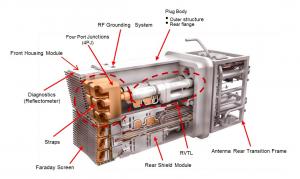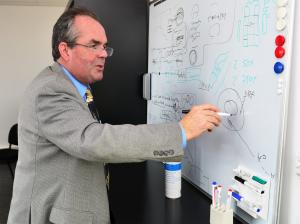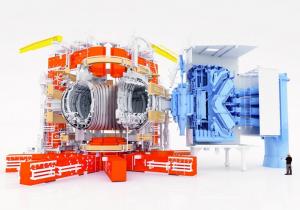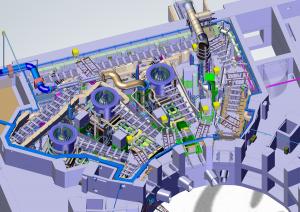Toujours plus chaud !
Pour un physicien, la température n'est pas seulement une mesure exprimant la chaleur ou le froid.
La température est également une mesure de l'énergie emportée par les atomes et les molécules, laquelle nous indique à quelle vitesse ils se déplacent au sein d'un solide, d'un liquide ou d'un gaz.
La température et la chaleur sont deux notions distinctes. Pour ressentir sous nos doigts la chaleur d'un objet, il faut que celui-ci présente une certaine densité. Plus cette densité est élevée, plus la quantité de chaleur transférée vers la peau sera importante. Ceci explique pourquoi il est possible de toucher sans se brûler un tube au néon contenant un plasma très chaud (~10 000°C) mais très peu dense.
En matière de température, on parle de froid absolu théorique (le « zéro absolu ») mais la notion de chaleur absolue n'existe pas. En effet, une particule peut toujours se déplacer plus rapidement qu'elle ne le fait mais elle ne peut pas être plus immobile...qu'immobile.
Le plasma de 150 à 300 millions de degrés qui sera confiné dans le tokamak ITER est un environnement dans lequel les particules (les ions de deutérium et de tritium ainsi que les électrons dissociés) se déplaceront à une vitesse prodigieuse, si rapidement et avec un tel niveau d'énergie que leur collision frontale aboutira au miracle de la fusion. La barrière électromagnétique séparant les noyaux sera franchie, si bien que ceux-ci pourront fusionner.
Le processus de chauffage du plasma sera initié par une décharge électrique, un peu comme lorsque l'on active le « starter » d'un tube au néon. Dans le mélange gazeux très ténu présent dans la chambre à vide (un million de fois moins dense que l'air que nous respirons), cette décharge électrique arrachera les électrons des atomes, et le gaz se transformera en plasma, une « soupe de particules » composée d'électrons et d'ions porteurs d'une charge électrique.
« Les électrons provenant du courant électrique entreront en collision avec les ions dont ils ont été arrachés, leur transférant ainsi leur énergie, explique Paul Thomas, le directeur général adjoint du département Chauffage & Diagnostics (CODAC) d'ITER. Le courant montera progressivement en intensité et, tandis que la résistance du plasma s'accroîtra sous l'effet des collisions entre les électrons et les ions, la température augmentera également. C'est ce qu'on appelle le 'chauffage ohmique', que l'on utilise au quotidien dans nos grille-pain, sèche-cheveux et radiateurs électriques. »
Cependant, contrairement aux métaux, les plasmas présentent une propriété de résistivité inhabituelle : plus ils sont chauds, plus leur résistivité diminue. En d'autres termes, le chauffage ohmique ne permet de chauffer un plasma que jusqu'à un certain point.
« Pendant longtemps, se souvient Paul Thomas, certains physiciens de la fusion ont rêvé d'atteindre la fusion à l'aide du seul chauffage ohmique, en augmentant l'intensité du champ magnétique. Aujourd'hui encore, le projet Ignitor se fonde sur cette approche. Mais un problème se pose : plus le champ magnétique est intense, plus la contrainte mécanique supportée par la structure de la machine est importante. »
La fusion exige toutefois des températures environ dix fois supérieures à celles que peut générer le seul chauffage ohmique, c'est pourquoi, dans les années 1970, la communauté de la fusion a commencé à concevoir des techniques de chauffage externe basées sur les ondes radiofréquence (RF) ou sur l'injection de particules très énergétiques dans le plasma.
En effet, les ondes radiofréquence sont capables de produire de la chaleur. Qu'elles possèdent une fréquence de 40 à 55 MHz, comme dans les radios à ondes courtes (fréquence cyclotronique ionique), de quelques GHz, comme dans les fours à micro-ondes (fréquence hybride basse), ou de plusieurs dizaines ou centaines de GHz, comme dans les radars les plus avancés (fréquence cyclotronique électronique), l'injection d'ondes électromagnétiques dans un plasma peut produire suffisamment d'énergie pour atteindre la température propice aux réactions de fusion. ITER sera équipé de systèmes de chauffage cyclotronique ionique et cyclotronique électronique délivrant chacun une puissance de 20 MW.
Mais le chauffage par injection de neutres (injection au cœur du plasma de particules neutralisées très énergétiques) demeure l'une des techniques de chauffage externe privilégiée dans les tokamaks.
On peut comparer le chauffage par injection de neutres à la buse de vapeur d'un percolateur utilisée pour réchauffer le lait lors de la préparation d'un cappuccino. Quand elles entrent en collision avec les molécules de lait froid, les molécules brûlantes du jet de vapeur leur transfèrent leur énergie, ce qui permet de réchauffer le lait avant de le verser dans la tasse.
« Les Japonais ont été les premiers à exploiter les technologies d'injection de neutres que nous utiliserons pour ITER, dit Paul Thomas. Nous travaillons en étroite collaboration avec nos amis de Naka. La technologie d'injection de neutres est également mise en œuvre dans le JET, mais le système d'injection de neutres d'ITER produira sept fois plus d'énergie que celui du JET. »
Les trois systèmes de chauffage d'ITER (cyclotronique électronique, cyclotronique ionique et injection de neutres) présentent différents niveaux de complexité technique, de maintenabilité et de facilité d'utilisation, c'est pourquoi, selon Paul Thomas, il est nécessaire de tester ces trois systèmes sur la machine ITER et de les développer jusqu'au stade qui permettra de décider lequel adopter pour chauffer le plasma d'un réacteur.
« Nous utiliserons ces trois systèmes de chauffage pour ITER afin de les mettre en concurrence dans l'environnement nucléaire, c'est l'objectif des essais de 'viabilité technologique' ».





